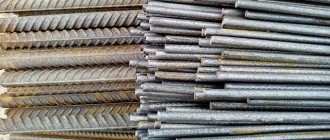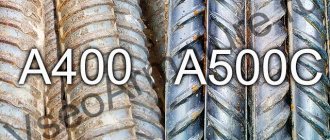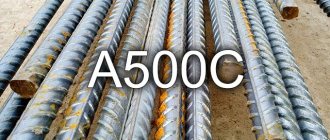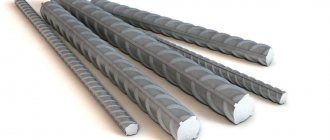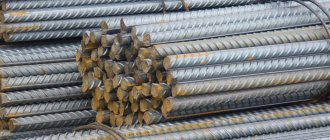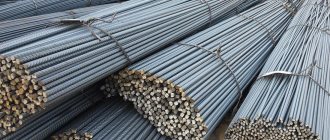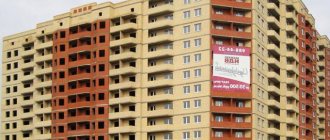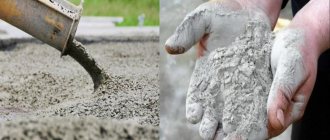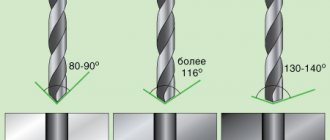Difference between fittings A1 and A3
Construction reinforcement, if taken externally, can be divided into two types or classes: A1 reinforcement and A3 reinforcement. Both of them are available in the form of rods and coils. Moreover, their weight, despite their differences, is also the same. So let's take a closer look at them:
- A1 fittings
are smooth, also marked as
A240 fittings
and are produced according to the GOST 5781-82 standard. It is a smooth round rod, 6, 11.7 or 12 meters long. It can also be produced in coils or coils, and these coils can be unwound and cut into rods. - A3 fittings
are corrugated fittings. Now it is already divided into several classes, for example A400 and A500. Produced according to several standards and specifications. For example, according to GOST R 52544-2006 and STO ASChM 7-93, for A500S fittings. And to produce the A400 reinforcing profile, they use GOST 5781-82, the same standard as for a smooth profile.
Type of periodic profile.
A special feature of the A500C reinforcement is its crescent profile. The few ribbed protrusions on the surface of the rod do not intersect with the longitudinal ribs. The arrangement of reliefs on the reinforcement of some manufacturers differs from others in terms of pitch and angle of inclination. Thanks to the profile configuration, rolled steel achieves high strength and ductility. Good tensile strength makes it ideal for use in structures with thin walls and prestressing.
The A3 reinforcement profile looks like a ring with many transverse protrusions connected to two longitudinal ribs. A3 is preferable to use in monolithic reinforced concrete structures, where the reinforcement exhibits a high degree of adhesion in the solution. This performance characteristic is another important difference from the A500C series.
Difference between A400 and A500 fittings
Marking A400 or A500 indicates strength class. The letter A means that the steel is reinforcing. As you can see, everything is simple. Further, the A500 brand may have additional markings as A500C. Here the letter C already means that it is reinforcing steel that is quite easy to weld. However, even without a designation, the reinforcement can be welded quite well with conventional electrodes.
A400 fittings are divided into brands:
- 25G2S
- 35GS
A500 fittings are available in the following brands:
- A500
- А500С
How to determine the class of reinforcement
The construction of concrete structures is rarely complete without a reinforcing frame. It is a structure made of metal wire (rods), which, after pouring concrete, will be completely hidden inside. The fittings are made from steel manufactured in accordance with GOST 5058-49, 380-88 (low-carbon, carbon grades). If we are talking about a composite material, then the basis is polymer (magmatic) fiber and organic resin. The class of fittings is encoded in the marking, for example, A400 means a rod made of low-alloy steel with an admixture of manganese (35GS, 25G2S, 32G2Rps).
Corrugated fittings A500S
Time does not stand still and these days, the class of fittings – A500C – is basking in the rays of popularity. There is no more universal material on the market for reinforced concrete structures. After the invention of this alloy, the above steels moved to the niche category; they remain in demand in high-rise construction and critical structures. Otherwise, A500C rules the roost, with high weldability, toughness, and at the same time a plastic and durable material.
It doesn’t care about electric arc welding; weldability indicators increase significantly due to the small amount of alloying elements. The cost, relative to its older brothers, is also pleasing to the eye.
Classification
The range of reinforcing bars is large; without experience in the construction industry, it is easy to get confused about which rolled metal to buy. Different tasks require the use of different types of elements to achieve the intended effect. Thus, longitudinal rods are often taken thicker than transverse ones, which play the role of a stiffening frame, while the main ones are needed to impart strength under bending and tensile loads.
The division of reinforcement into classes significantly simplifies the choice. Up to a dozen criteria are involved in the classification, they are briefly reflected in the marking - this is the steel grade, relative elongation after break, temporary tensile strength, diameter (by profile). This list is sufficient for the average person; specialists use a larger number only in project calculations.
Table 1. Typical characteristics of fittings
| Reinforcement class | Profile diameter, mm | Tensile strength, MPa | Relative elongation after rupture, % | steel grade |
| AI (A240) | 6-40 | 373 | 25 | St3kp, St3ps, St3sp |
| AII (A300) | 10-40 40-80 | 490 | 19 | St5sp, St5ps 18G2S |
| ACII (AC300) | 10-32 | 441 | 25 | 10GT |
| AIII (A400) | 6-22 6-40 | 590 | 14 | 35GS, 25G2S 32G2Rps |
| AIV (A600) | 10-32 | 883 | 6 | 80С, 20ХГ2Ц |
| AV (A800) | 10-32 | 1030 | 7 | 23ХГ2Ц |
The cross-section of the reinforcing bar is selected based on the dimensions of the concrete structure and strength requirements. The measurement is carried out by the outer diameter, taking into account the profile. Other parameters also affect the final properties of the concrete product, primarily the load capacity. Thus, the temporary tensile strength indicates the tensile strength of the structure. The indicator of relative elongation after rupture provides insight into deformation in the event of severe damage to the metal frame. Typically, steel bars return to a state close to their original state when the tensile force is removed.
Corrugated fittings 25G2S
In view of this, as well as the significantly excessive strength of this alloy for less massive structures, it was decided to increase the variability of materials. Thus, the second figure in our story appears on the stage - corrugated fittings 25G2S, the composition of which was slightly shuffled, namely, the ratio of manganese and carbon increased in favor of the first.
This made it possible to increase the weldability of the material, but reduced its strength. The game was worth the candle - 25G2S reinforcement, for a long time found true popular love, becoming the most popular alloy for fittings.
Corrugated fittings 35GS
Let's start in order: in the beginning there was a word, or rather the designation of the alloy - 35GS, which, in its composition with alloying elements, a high content of manganese, which guarantees increased flexibility, and carbon, which strengthens the alloy, made it possible to increase the height of construction - to become “closer to the sky.”
Everything would be fine, but the weldability of corrugated reinforcement of steel grade 35GS leaves much to be desired, so more time, material and money had to be spent on creating structures.
Bottom line
Thus, the bottom line is that we have 3 classes of reinforcement, with different strength characteristics, easily welded and absolutely not allowing such actions, plastic like a Bolshoi Theater ballerina and truly “wooden”. All of them are good and in demand in their own way; the variability of choice allows you to calculate and make the optimal choice according to all characteristics, for any project.
Many mega projects require the development of new solutions; thanks to new projects, new building materials are being developed.
This is exactly what the new type of reinforcing steel A400 has become. Return to list
Classes and their differences
The fittings are marked in two ways - a designation for those who are accustomed to relying on old directories, and also a new identifier, which is mentioned in the new standards and is used on the international market. This approach simplifies the reading of construction documentation and eliminates misreading of information. Sometimes the choice is made based on external signs. For example, smooth is usually “first class”.
The coding of reinforcing metal products begins with the letter:
- A – hot-rolled or cold-rolled steel;
- B – cold-deformed material;
- K – rope products.
In the outdated standard, reinforcement is designated by classes (Roman numerals from I to VI). In the new one, the numbers indicate the fluidity index of steel in MPa. This approach allows you to determine its parameters without reading special literature. Each type of rod has its own purpose, so it is important to consider the characteristics at the design stage, before purchasing the material.
The following series of fittings are produced:
- A-I (A240) – mounting rod with a smooth profile made of steel grades St3SP, St3PS, St3KP with a cross-section of 4-40 mm.
- A-II (A300) - an analogue of the previous brand, but with a corrugated surface, made of ST5SP (PS) or ST18G2S metal with a diameter of 10-80 mm, can be produced in the form of wire, in coils of 6-12 m.
- A-III (A400) – reinforcement for foundation frames of slab, strip, pile type made of steel grade 35GS, 25G2S, 32G2R with a cross-section of 6-40 mm (there is a modification with the index “B” made of cold drawn metal).
- A-IV (A600) is a material for welded structures, produced both in the form of rods of 6, 9, and coils of 12 m, with a diameter of 10-32 mm from low-alloy cold-rolled steel 80S, 20ХГ2Ц.
- AV (A800) – products for welded frames in standard, prestressed concrete products, made of steel 23Х2Г2Т, with a cross-section of 6-32 mm.
- A-VI (A1000) – high-strength reinforcement for the production of slabs for extended spans, made of metal grades 22Х2Г2АУ, 22Х2Г2Р, 20Х2Г2СС, with a diameter of 6-32 mm.
After the alphanumeric marking, price lists usually indicate the outer diameter, so that when selecting building materials it is easy to do without inspecting the products. It is also possible to apply additional symbols that indicate a specific coating of the rod, for example, to increase corrosion resistance.
Specifications
The main technical characteristics of A500C fittings include:
| compression resistance | 450 MPa; |
| minimum operating temperature | -55 C; |
| bend angle | 180 degrees; |
| tensile strength | 600 MPa; |
| yield strength | 500 MPa. |
The reinforcement has toughness, ductility, flexibility and weldability due to the use of low-alloy steel as the main material. During production, it can be coated with a thin layer of zinc, which provides anti-corrosion qualities and durability when poured with concrete.
Return to content
Application difference
In general, both classes are used for reinforcing critical elements of reinforced concrete structures: foundations, columns, in the construction of bridges, subways. AIII reinforcement is used to strengthen road surfaces.
A400 rods are produced from steels 35GS, 25G2S and 32G2Rps. Arc welding is prohibited for alloy 35GS, this is due to a sharp decrease in ductility and flexibility at the joints. Bends and welded joints created by more expensive methods cannot withstand bending.
Reinforcement made from 25G2S, on the contrary, is characterized by high weldability due to the reduced carbon component. 32G2Rps, alloyed with aluminum and copper, is used for prestressed reinforced concrete structures.
A500 fittings can be made from cheap carbon steel, since only the composition is regulated, not the brand. The range includes ST3sp and ST3ps, 25G2S. The rods are welded without restrictions, this affects the price, cost of work, and costs of production processes. Minimum diameters were added: 4 and 5 mm, at customer request - 4.5 and 5.5 mm.
Thus, the differences in application lie in some important aspects:
- Increased weldability reduces installation time; workers do not have to tie the rods together manually;
- Maintaining the flexibility of welds provides a margin of safety and expands the possibilities for implementing complex architectural forms. The yield strength indicates the ultimate bending and tensile loads. The difference reaches 28%;
- The low price allows the use of A500 in all types of structures: loaded and unloaded, A400 is used only for stressed elements;
- A400 is used for the construction of bridges and tunnels with constant and variable loads, and for the installation of road surfaces. The use of A500 is illegal, as there are currently no dynamic test results available;
- According to GOST 34028-2016, at a design temperature below -55 C⁰, it is recommended to use rods of execution Ac500S and A600 made of steel 20G2SFBA. For some areas of the Far North, class A3 fittings are not suitable, its limit is -40 C⁰.
Price
Delivery of the material is carried out throughout Russia. To place an order, you can leave a request on the website or contact our manager. In the shortest possible time, a commercial offer is formed based on market offers, which takes into account current discounts and promotions. Depending on the availability of fittings in the warehouse, the cost and delivery time are determined.
On average, the cost of a ton of A500C reinforcement is:
- d = 20 mm – 23.8-30.9 thousand rubles;
- d = 12 mm – 24.1-31.5 thousand rubles;
- d = 10 mm – 25.1-28.7 thousand rubles;
- d = 6 mm – 27.4-30.3 thousand rubles.
Return to content
Differences in appearance
Both classes have a grooved surface, which increases adhesion to concrete but reduces corrosion resistance. Despite the fact that the brands are largely considered analogues, different designs are provided.
External differences affect performance characteristics. When using A500 profiles, you can reduce material consumption in stressed areas by 10%. Corrosion develops faster on a corrugated surface than on a smooth one. Depending on the choice of steel grades for reinforcement 500, this parameter can be adjusted.
Determination by eye
The method of visually determining the class of reinforcement will be useful to those who have to deal with construction work regularly. Thus, a smooth profile always indicates category I-II; rods of a higher class are always made with a ring, crescent or mixed pattern. After approximately determining the brand of reinforcement, it is recommended to study the rod diameter, weight, and length.
Industrial products of class AV and A-VI are easily distinguished by their large cross-section, with an enlarged profile. They are also distinguished by their increased length and increased massiveness. For the rest, it is better to focus on the markings. After all, the type of coating or grade of steel cannot be determined at a glance, as well as suitability for welding.
Manufacturing process
The production of fittings of this brand is a rather complex technological process. To begin with, different methods are used in the manufacture of A500C reinforcement: cold-drawn and hot-rolled. The first method is suitable for the production of rolled and wire rods, and the second is used when it is necessary to create rod ones. It is worth noting that the latter has higher strength than most analogues made by other methods.
In addition, the alloy itself contains less carbon than, for example, reinforcing steel for A400. This slightly reduces strength, but increases corrosion resistance, while at the same time allowing the use of welding when assembling the frame, which significantly simplifies the work process.
Popular manufacturing companies
The best manufacturers of A500C fittings include:
- OJSC "OEMK";
- Novorosmetall LLC;
- OJSC NLMK-Ural;
- SJSC "MMZ" (Moldova);
- AEMZ LLC;
- LLC "TD BMZ";
- PJSC "ArcelorMittal Krivoy Rog";
- OJSC Severstal;
- OJSC "EVRAZ ZSMK".
This conclusion was made based on the findings of ordinary consumers and specialists. High quality is due to compliance with production, control and material release standards. This ensures the durability of the rods.
Return to content
